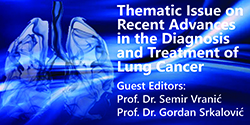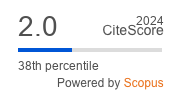The Influence of Sociodemographic Characteristics, Lifestyle, and Metabolic Syndrome on Anxiety and Depression Symptoms in Adults in Banja Luka
DOI:
https://doi.org/10.5644/ama2006-124.483Keywords:
Metabolic Syndrome, Anxiety, DepressionAbstract
Objective. This study aimed to explore the influence of sociodemographic characteristics and lifestyle on the occurrence of anxiety and depression, and the interrelationship between metabolic syndrome (MS) and anxiety and depression.
Methods. A total of 685 adults were divided into two groups (with and without MS) using the International Diabetes Federation’s definition of MS. In both groups, we used the Beck Inventory for Anxiety and Depression. The influence of sociodemographic and other characteristics on the occurrence of MS, anxiety, and depression was observed. The multivariate logistic regression model was appropriate for determining which variables (especially anxiety and depression) affected the presence of MS in the participants.
Results. MS was observed in 37.5% of participants. Women with mild and severe anxiety were statistically significantly more represented in the group with MS than in the group without MS (26.2% : 12.0%, P=0.001; 16.7% : 4.8%, P=<0.001), as well as women with severe depression (6.3% : 1.9%, P=0.038), while there was no significant difference in men. Sociodemographic characteristics such as female gender, older age, employment status (retirees and homemakers), lower level of education, marital status (divorced and widowed), and more children affected the occurrence of anxiety and depression in participants. Physical inactivity during leisure time, high-risk drinking, and a higher level of cardiovascular risk showed significant influence on the presence of anxiety and depression, while smoking was inversely associated with the presence of depression but not with anxiety.
Conclusion. The association between MS and anxiety and depression was confirmed. Women with MS were at a higher risk of anxiety and depression symptoms, whereas this was not confirmed in men.
References
Alberti KG, Eckel RH, Grundy SM, Zimmet PZ, Cleeman JI, Donato KA, et al. Harmonizing the metabolic syn- drome: a joint interim statement of the International Diabetes Federation Task Force on Epidemiology and Prevention; National Heart, Lung, and Blood Institute; American Heart Association; World Heart Federation; International Atherosclerosis Society; and International Association for the Study of Obesity. Circulation. 2009;120(16):1640-5. doi: 10.1161/CIRCULATIONAHA.109.192644. Epub 2009 Oct 5.
Alberti KG, Zimmet P, Shaw J. Metabolic syndrome-a new world-wide definition. A Consensus Statement from the International Diabetes Federation. Diabet Med. 2006;23(5):469-80. doi: 10.1111/j.1464-
5491.2006.01858.x.
Centers for Disease Control and Prevention. Diabetes Report Card 2017. Atlanta, GA: Centers for Disease Control and Prevention, US Dept of Health and Human Services; 2018.
Saklayen MG. The Global Epidemic of the Metabolic Syndrome. Curr Hypertens Rep. 2018;20(2):12. doi: 10.1007/ s11906-018-0812-z.
GBD 2015 Obesity Collaborators; Afshin A, Forouzanfar MH, Reitsma MB, Sur P, Estep K, et al. Health Effects of Overweight and Obesity in 195 Countries over 25 Years. N Engl J Med. 2017;377(1):13-27. doi: 10.1056/NEJ- Moa1614362. Epub 2017 Jun 12.
Topic R, Milicic D, Stimac Z, Loncar M, Velagic V, Marcinko D, et al. Somatic comorbidity, metabolic syndrome, cardiovascular risk, and CRP in patients with recurrent depressive disorders. Croat Med J. 2013;54(5):453-9. doi: 10.3325/cmj.2013.54.453.
Marijnissen RM, Smits JE, Schoevers RA, van den Brink RH, Holewijn S, Franke B, et al. Association between metabolic syndrome and depressive symptom profiles-sex-specific? J Affect Disord. 2013;151(3):1138-42. doi: 10.1016/j.jad.2013.07.029. Epub 2013 Aug 23.
East C, Willis BL, Barlow CE, Grannemann BD, FitzGerald SJ, DeFina LF, et al. Depressive symptoms and metabolic syndrome in preventive healthcare: the Cooper Center longitudinal study. Metab Syndr Relat Disord. 2010;8(5):451-7. doi: 10.1089/met.2010.0017.
Akbaraly TN, Kivimäki M, Brunner EJ, Chandola T, Marmot MG, Singh-Manoux A, et al. Association between metabolic syndrome and depressive symptoms in middleaged adults: results from the Whitehall II study. Diabetes Care. 2009;32(3):499-504. doi: 10.2337/dc08-1358. Epub 2008 Dec 23.
Carnethon MR, Loria CM, Hill JO, Sidney S, Savage PJ, Liu K, et al. Risk factors for the metabolic syndrome: the Coronary Artery Risk Development in Young Adults (CAR- DIA) study, 1985-2001. Diabetes Care. 2004;27(11):2707-15. doi: 10.2337/diacare.27.11.2707.
Meigs JB, D‘Agostino RB Sr, Wilson PW, Cupples LA, Nathan DM, Singer DE. Risk variable clustering in the insulin resistance syndrome. The Framingham Offspring Study. Diabetes. 1997;46(10):1594-600. doi: 10.2337/diacare.46.10.1594.
Park YW, Zhu S, Palaniappan L, Heshka S, Carnethon MR, Heymsfield SB. The metabolic syndrome: prevalence and associated risk factor findings in the US population from the Third National Health and Nutrition Examination Survey, 1988-1994. Arch Intern Med. 2003;163(4):427-36. doi: 10.1001/archinte.163.4.427.
UNESCO. International Standard Classification of Education – ISCED 97. Revised in Paris: UNESCO; 2008.
International Labour Organisation (ILO). International Standard Classification of Occupations, ISCO-08. Geneve, 2007.
Petrovic V, Tesanovic G, Stanivuk LJ. Prevalence of meta- bolic syndrome and the association with sociodemographic characteristics in adult population of Banja Luka. Vojnosanit Pregl. 2018;75(5):447-52. doi: https://doi. org/10.2298/VSP160716346P.
Smith L. New AHA Recommendations for Blood Pressure Measurement. Practice Guidelines. Am Fam Physician. 2005;72(7):1391-8.
Mancia G, Fagard R, Narkiewicz K, Redon J, Zanchetti A, Böhm M, et al. 2013 ESH/ESC guidelines for the management of arterial hypertension: the Task Force for the Management of Arterial Hypertension of the European Society of Hypertension (ESH) and of the European Society of Cardiology (ESC). Eur Heart J. 2013;34(28):2159-219. doi: 10.1093/eurheartj/eht151. Epub 2013 Jun 14.
Institute for Health Protection of the Republic of Srpska. Professional instructions for the detection and reduction of risk factors and early detection of diseases from the Program for the Prevention and Control of Non-Communicable Diseases in the Republic of Srpska. Banja Luka: Health Insurance Fund RS 2003.
Beck AT, Steer RA, Ball R, Ranieri W. Comparison of Beck Depression Inventories -IA and -II in psychiatric outpatients. J Pers Assess. 1996;67(3):588-97. doi: 10.1207/ s15327752jpa6703_13.
Beck AT, Epstein N, Brown G, Steer RA. An inventory for measuring clinical anxiety: psychometric properties. J Consult Clin Psychol. 1988;56(6):893-7. doi: 10.1037//0022-006x.56.6.893.
WHO. Global recommendations on physical activity for health. Geneva: World Health Organization; 2010.
Stojisavljević D, Danojević D, Bojanić J, Jandrić Lj. A guide to proper nutrition for healthcare professionals [in Serbian]. Banja Luka: Institute for Health Protection of the Republic of Srpska; 2004.
Department of Agriculture and U.S. Department of Health and Human Services. Dietary Guidelines for Americans, 2010. 7th Edition. Washington: U.S. Government Printing Office; 2010.
UNESCO. International Standard Classification of Education – ISCED 97. Paris: UNESCO; 2008.
Perk J, De Backer G, Gohlke H, Graham I, Reiner Z, Verschuren M, et al. European Guidelines on cardiovascular disease prevention in clinical practice (version 2012). The Fifth Joint Task Force of the European Society of Cardiology and Other Societies on Cardiovascular Disease Prevention in Clinical Practice (constituted by representatives of nine societies and by invited experts). Eur Heart J. 2012;33(13):1635-701. doi: 10.1093/eurheartj/ehs092. Epub 2012 May 3. Erratum in: Eur Heart J. 2012 Sep;33(17):2126.
Dolanbay T, Vural A, Altay MC, Çınaroglu NS. Level of Work-Related Anxiety and Potential Causes of Anxiety in Healthcare Workers in the Emergency Department. Psychiatry Investig. 2024;21(11):1299-307. doi: 10.30773/ pi.2024.0265. Epub 2024 Nov 18.
Chlapecka A, Wolfová K, Fryčová B, Cermakova P. Ed- ucational attainment and anxiety in middle-aged and older Europeans. Sci Rep. 2023;13(1):13314. doi: 10.1038/ s41598-023-40196-4.
Kim SY, Jeon SW, Lee MY, Shin DW, Lim WJ, Shin YC, et al. The Association between Physical Activity and Anxiety Symptoms for General Adult Populations: An Analysis of the Dose-Response Relationship. Psychiatry Investig. 2020;17(1):29-36. doi: 10.30773/pi.2019.0078. Epub 2019 Dec 23.
Stubbs B, Koyanagi A, Hallgren M, Firth J, Richards J, Schuch F, et al. Physical activity and anxiety: A perspective from the World Health Survey. J Affect Disord. 2017;208:545-52. doi: 10.1016/j.jad.2016.10.028. Epub 2016 Oct 25.
Covey LS, Hu MC, Winhusen T, Lima J, Berlin I, Nunes E. Anxiety and Depressed Mood Decline Following Smoking Abstinence in Adult Smokers with Attention Deficit Hyperactivity Disorder. J Subst Abuse Treat. 2015;59:104-8. doi: 10.1016/j.jsat.2015.07.004. Epub 2015 Jul 17.
Johannessen EL, Andersson HW, Bjørngaard JH, Pape K. Anxiety and depression symptoms and alcohol use among adolescents - a cross sectional study of Norwegian secondary school students. BMC Public Health. 2017;17(1):494. doi: 10.1186/s12889-017-4389-2.
Shahab L, Andrew S, West R. Changes in prevalence of depression and anxiety following smoking cessation: results from an international cohort study (AT- TEMPT). Psychol Med. 2014;44(1):127-41. doi: 10.1017/ S0033291713000391. Epub 2013 Mar 14.
Economou A, Konsolaki E, Kalsi IA, Psychountaki M. The Beck Depression Inventory-II in Community-Dwelling Middle-Aged and Older Greeks: Factor Structure and De- mographic Associations. SAGE Open. 2024;14(2):1-11. doi: 10.1177/21582440241252264.
de Sá Junior AR, Liebel G, de Andrade AG, Andrade LH, Gorenstein C, Wang YP. Can Gender and Age Impact on Response Pattern of Depressive Symptoms Among College Students? A Differential Item Functioning Analysis. Front Psychiatry. 2019;10:50. doi: 10.3389/ fpsyt.2019.00050.
Ciharova M, Cígler H, Dostálová V, Šivicová G, Bezdicek O. Beck depression inventory, second edition, Czech version: demographic correlates, factor structure and comparison with foreign data. Int J Psychiatry Clin Pract. 2020;24(4):371-9. doi: 10.1080/13651501.2020.1775854. Epub 2020 Jun 18.
Queiroga LL, Kaufmann O, Ritti-Dias RM, da Cunha PM, Minanni CA, Pitta RM, et al. Physical activity levels are associated with depressive symptoms: A cross-sectional study of 58,445 adults. J Affect Disord. 2025;369:298-302. doi: 10.1016/j.jad.2024.09.158. Epub 2024 Sep 26.
Maier A, Riedel-Heller SG, Pabst A, Luppa M. Risk factors and protective factors of depression in older people 65+. A systematic review. PLoS One. 2021;16(5):e0251326. doi: 10.1371/journal.pone.0251326.
Barlow DH, Ellard KK, Sauer-Zavala S, Bullis JR, Carl JR. The Origins of Neuroticism. Perspect Psychol Sci. 2014;9(5):481-96. doi: 10.1177/1745691614544528.
Albert PR. Why is depression more prevalent in women? J Psychiatry Neurosci. 2015;40(4):219-21. doi: 10.1503/jpn.150205.
Ferreira-Hermosillo A, Molina-Ayala M, Ramírez-Rent- ería C, Vargas G, Gonzalez B, Isibasi A, et al. Inflammato- ry Cytokine Profile Associated with Metabolic Syndrome in Adult Patients with Type 1 Diabetes. J Diabetes Res. 2015;2015:972073. doi: 10.1155/2015/972073. Epub 2015 Jul 27.
Martin LA, Neighbors HW, Griffith DM. The experience of symptoms of depression in men vs women: analysis of the National Comorbidity Survey Replication. JAMA Psychiatry. 2013;70(10):1100-6. doi: 10.1001/jamapsychiatry.2013.1985.
Maurer DM, Raymond TJ, Davis BN. Depression: Screening and Diagnosis. Am Fam Physician. 2018;98(8):508-515.
Call JB, Shafer K. Gendered Manifestations of Depression and Help Seeking Among Men. Am J Mens Health. 2018;12(1):41-51. doi: 10.1177/1557988315623993. Epub 2015 Dec 31.
Rothon C, Edwards P, Bhui K, Viner RM, Taylor S, Stansfeld SA. Physical activity and depressive symptoms in adolescents: a prospective study. BMC Med. 2010;8:32. doi: 10.1186/1741-7015-8-32.
Shigdel R, Stubbs B, Sui X, Ernstsen L. Cross-sectional and longitudinal association of non-exercise estimated cardiorespiratory fitness with depression and anxiety in the general population: The HUNT study. J Affect Disord. 2019;252:122-9. doi: 10.1016/j.jad.2019.04.016. Epub 2019 Apr 8.
Kramer NE, Cosgrove VE, Dunlap K, Subramaniapillai M, McIntyre RS, Suppes T. A clinical model for identifying an inflammatory phenotype in mood disorders. J Psychiatr Res. 2019;113:148-58. doi: 10.1016/j.jpsychires.2019.02.005. Epub 2019 Feb 10.
van Reedt Dortland AK, Giltay EJ, van Veen T, Zitman FG, Penninx BW. Metabolic syndrome abnormalities are associated with severity of anxiety and depression and with tricyclic antidepressant use. Acta Psychiatr Scand. 2010;122(1):30-9. doi: 10.1111/j.1600-0447.2010.01565.x. Epub 2010 Apr 26.
Hiles SA, Révész D, Lamers F, Giltay E, Penninx BW. BIDIRECTIONAL PROSPECTIVE ASSOCIATIONS OF METABOLIC SYNDROME COMPONENTS WITH DEPRESSION, ANXIETY, AND ANTIDEPRESSANT USE. Depress Anxiety. 2016;33(8):754-64. doi: 10.1002/ da.22512. Epub 2016 Apr 27.
Butnoriene J, Steibliene V, Saudargiene A, Bunevicius A. Does presence of metabolic syndrome impact anxiety and depressive disorder screening results in middle aged and elderly individuals? A population based study. BMC Psychiatry. 2018;18(1):5. doi: 10.1186/s12888-017-1576-8.
Ji S, Chen Y, Zhou Y, Cao Y, Li X, Ding G, et al. Associa- tion between anxiety and metabolic syndrome: An updated systematic review and meta-analysis. Front Psychiatry. 2023;14:1118836. doi: 10.3389/fpsyt.2023.1118836.
Miettola J, Niskanen LK, Viinamäki H, Kumpusalo E. Metabolic syndrome is associated with self-perceived depression. Scand J Prim Health Care. 2008;26(4):203-10. doi: 10.1080/02813430802117624.
Moradi Y, Albatineh AN, Mahmoodi H, Gheshlagh RG. The relationship between depression and risk of metabolic syndrome: a meta-analysis of observational studies. Clin Diabetes Endocrinol. 2021;7(1):4. doi: 10.1186/s40842-021-00117-8.
Ribeiro RP, Marziale MHP, Martins JT, Ribeiro PHV, Robazzi MLCC, Dalmas JC. Prevalence of Metabolic Syndrome among nursing personnel and its association with occupational stress, anxiety and depression. Rev Latino- Am Enfermagem. 2015;23(3):435-40.
Dunbar JA, Reddy P, Davis-Lameloise N, Philpot B, Laatikainen T, Kilkkinen A, et al. Depression: an important comorbidity with metabolic syndrome in a general population. Diabetes Care. 2008;31(12):2368-73. doi: 10.2337/ dc08-0175. Epub 2008 Oct 3.
Womack VY, De Chavez PJ, Albrecht SS, Durant N, Loucks EB, Puterman E, et al. A Longitudinal Relationship Between Depressive Symptoms and Development of Metabolic Syndrome: The Coronary Artery Risk De- velopment in Young Adults Study. Psychosom Med. 2016;78(7):867-73. doi: 10.1097/PSY.0000000000000347.
Rebolledo-Solleiro D, Roldán-Roldán G, Díaz D, Velasco M, Larqué C, Rico-Rosillo G, et al. Increased anxiety-like behavior is associated with the metabolic syndrome in non-stressed rats. PLoS One. 2017;12(5):e0176554. doi: 10.1371/journal.pone.0176554.
Downloads
Published
License
Copyright (c) 2025 Verica Petrović, Maja Račić, Biljana Lakić

This work is licensed under a Creative Commons Attribution 4.0 International License.






